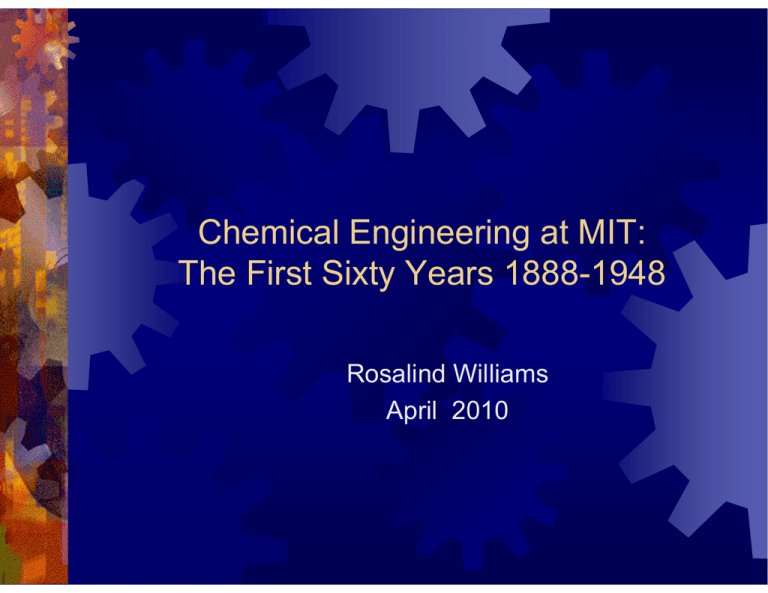
Chemical Engineering at MIT:
The First Sixty Years 1888-1948
Rosalind Williams
April 2010
Warren Kendall Lewis
1886-1972
Note: Warren Kendall Lewis is Prof. Williams' grandfather.
Many of the images in this presentation are from her personal archive.
Spring Garden Farm
Laurel, Delaware
45 Hunnewell Avenue
Newton, Massachusetts
The streetcar suburbs of
Boston 1886 (Warner, 1969)
© Harvard University Press. All rights reserved. This content is excluded from our
Creative Commons license. For more information, see http://ocw.mit.edu/fairuse.
The streetcar suburbs in 1901
(Warner, 1969)
© Harvard University Press. All rights reserved. This content is excluded from our
Creative Commons license. For more information, see http://ocw.mit.edu/fairuse.
Railroads around Boston
(Warner, 1969)
© Harvard University Press. All rights reserved. This content is excluded from our
Creative Commons license. For more information, see http://ocw.mit.edu/fairuse.
This image is public domain.
Increasing number of engineers
in US 1880 - 1920
Number
of practicing engineers
multiplied ca. 20-fold (7000 to 136,000)
Engineering
enrollments in land grant
colleges went up 40-fold
Class origins of engineers (1924
survey)
“drawn
from ….poorer and less welleducated segments of the middle class”
Many parents had small businesses or
were farmers
13% fathers had college degrees
40% fathers had finished high school
90% freshmen had to work a year
before starting college
“Boston Tech” in early 1900s
This image is public domain.
Industrial chemistry lab at MIT
1893
This image is public domain.
Arthur A. Noyes
This image is public domain.
William H. Walker
This image is public domain.
Walker’s innovations:
Science-based engineering
Unit operations
Research Lab in Applied Chemistry
Practice school
Chemical engineering majors
at MIT, Class of 1905
This image is public domain.
This image is public domain.
This image is public domain.
This image is public domain.
This image is public domain.
This image is public domain.
This image is public domain.
Image removed due to copyright restrictions
See:
http://upload.wikimedia.org/wikipedia/commons/6/69/US_WWI_Gas_mask_with_bag.JPG
This image is public domain.
Schematic flow diagram of a Fluid
Catalyic Cracker
This image is public domain.
The Lewis Report, 1949:
In our increasingly complex society, science
and technology can no longer be segregated
from their human and social consequences.
The most difficult and complicated problems
confronting our generation are in the field of
the humanities and social sciences…they
have resulted in large measure from the
impact of science and technology upon
society…
The human-built world:
“We are well on our way, in our timeless
effort to bring the natural environment
under control, to replacing it by an
artificial environment of our own
contriving.”
MIT historian Elting Morison, 1946
Doc Lewis, in his older years:
“If I could be reincarnated, I would like to
return as a social scientist. That is
where the really difficult and important
problems are.”
20-year decline in engineering
enrollments
Total
bachelor’s degrees in US in 1966:
35,826
Total bachelor’s degrees in US in 2001:
59,258
Peak enrollments (over 70,000) in 19831988
NSF data on chemical
engineering degrees in US
Bachelor’s degrees doubled 1966 to 2001
(ca. 3000 to ca. 6000)
Master’s degrees up modestly (1072 to 1368)
Doctoral degrees approximately doubled (367
to 727)
Number of women up 10X for bachelor’s, 50X
for master’s, 90X for doctoral degrees
Some signs of the times:
Among
MIT alums from the 1990s, only
21% aspired to be “technical leaders”
(30% wanted to be “entrepreneurs”)
In 1994-95 only 4.7% of firms recruiting
at MIT represented companies in
traditional engineering fields such as oil,
chemicals, materials, or food
MIT OpenCourseWare
http://ocw.mit.edu
STS.007 Technology in History
Fall 2010
For information about citing these materials or our Terms of Use, visit: http://ocw.mit.edu/terms.

